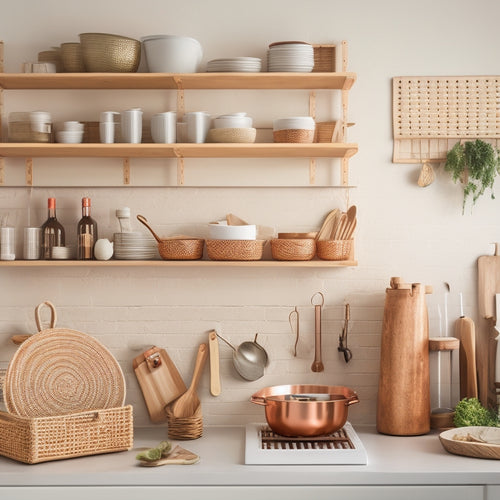
Sink Weight Raises Cabinet Safety Concerns
Share
Heavy sink installations, particularly those featuring cast iron sinks, pose significant structural risks to base cabinets. These sinks can weigh thousands of pounds, putting immense pressure on the cabinet's framing strength. To mitigate this risk, it is essential to assess the cabinet's framing strength and identify potential weak points. Even weight distribution and reinforcement strategies, such as support beams and reinforced base platforms, can help guarantee stability and durability. Proper support and stability measures are vital to prevent accidents and cabinet damage or collapse. Understanding the complexities of sink weight and cabinet safety will reveal effective solutions to guarantee a secure and reliable setup.
Key Takeaways
• Cast iron sinks can weigh thousands of pounds, posing significant structural risks to base cabinets if not properly supported.
• Assessing the cabinet's framing strength is crucial to ensure it can handle the sink's weight without compromising its integrity.
• Reinforcement options, such as support beams and reinforced base platforms, can be employed to distribute the sink's weight evenly and reduce safety risks.
• Prioritizing stability and durability in sink setup is essential to prevent accidents and mitigate potential safety hazards.
• Expert guidance from experienced contractors or carpenters can provide valuable insights into necessary reinforcement measures to ensure cabinet safety.
Sink Weight and Structural Risks
The significant weight of a cast iron sink, which can reach thousands of pounds, poses important structural risks to the base cabinet, necessitating a thorough assessment of the cabinet's framing strength and potential need for reinforcement.
This behemoth of a sink demands attention to sink weight distribution, ensuring even pressure on the cabinet to prevent uneven stress.
The cabinet's durability is put to the test, and it's vital to evaluate its ability to withstand the weight without compromising its structural integrity.
A thorough examination of the cabinet's framing strength will help determine if additional support is required to prevent catastrophic failures.
Assessing Cabinet Framing Strength
Cabinet framing strength assessment begins with a thorough examination of the existing structure. This process focuses on the type and quality of materials used, as well as the construction methods employed to build the cabinet.
Evaluating load bearing capabilities is vital to determine if the cabinet can support the weight of the sink. A closer look at the framework's design and construction helps identify potential weak points that may compromise the cabinet's structural integrity.
Reinforcement Options and Solutions
Evaluating various reinforcement strategies is crucial to make sure the sink's weight is distributed evenly and safely across the cabinet structure.
To achieve this, reinforcement techniques such as adding support beams can be employed to distribute the weight more efficiently.
A custom solution may also be necessary, involving the installation of a reinforced base platform for extra stability. This approach guarantees the sink's weight is evenly spread, reducing the risk of cabinet damage or collapse.
Ensuring Safety and Stability
To mitigate potential safety hazards, it is essential to prioritize stability and durability in the sink setup, ensuring that the heavy sink's weight is properly supported to prevent accidents or injuries. Implementing stability measures and safety precautions can greatly reduce the risk of cabinet damage or collapse.
| Stability Measures | Weight Distribution | Cabinet Longevity |
|---|---|---|
| Reinforced base platform | Even weight distribution | Increased cabinet lifespan |
| Additional support beams | Reduced stress on cabinet | Enhanced cabinet strength |
| High-quality materials | Improved weight management | Minimized risk of collapse |
| Custom reinforcement solutions | Optimized weight support | Extended cabinet durability |
| Regular maintenance checks | Preventive measures against wear | Prolonged cabinet performance |
Expert Guidance and Recommendations
Seeking guidance from at least three experienced contractors or carpenters who have handled similar heavy sink installations can provide valuable insights into the necessary reinforcement measures. These professionals can offer contractor consultation, sharing their carpentry insights on the reinforcement necessity for your specific cabinet structure.
Renovation specialists can also provide expert advice on the best approaches to guarantee the sink's weight is safely supported. By gathering multiple recommendations, you can make an informed decision on the most effective reinforcement strategy.
Don't be afraid to ask questions or seek a second opinion – it's better to be safe than sorry. With expert guidance, you can confidently move forward with your sink installation, knowing your cabinet is secure and stable.
Frequently Asked Questions
Can I Use a Lighter Sink Material to Reduce Structural Stress?
Did you know that a single cast iron sink can weigh up to 1,000 pounds? Considering sink alternatives, material options like stainless steel, copper, or solid surface sinks can greatly reduce structural stress, offering a safer and more durable solution.
How Do I Determine the Maximum Weight Capacity of My Cabinet?
To determine the maximum weight capacity of your cabinet, examine the Cabinet Anatomy, including shelf thickness and material, and perform Load Calculations, considering factors like dead loads, live loads, and safety factors to guarantee a structurally sound installation.
Are There Any Building Codes for Sink Installations I Should Follow?
When installing a sink, adhering to building codes is essential; research local permit requirements and inspector oversight to guarantee compliance, as codes vary by region, governing factors such as weight capacity and structural integrity.
Can I Reinforce the Cabinet Myself or Do I Need a Professional?
When considering DIY reinforcement, weigh DIY fears of improper installation against professional costs; if unsure, consult experts to guarantee a safe and sturdy cabinet, as improper reinforcement may lead to catastrophic consequences.
Will the Added Reinforcement Affect the Cabinet's Aesthetic Appeal?
When reinforcing a cabinet, it's essential to take into account the visual balance and design harmony to avoid compromising the aesthetic appeal. Strategic placement of support beams or platforms can maintain the cabinet's original look while ensuring stability and safety.
Related Posts
-

Revolutionize Your Kitchen Storage With These Ideas
You're ready to revolutionize your kitchen storage! Start by incorporating ladder-accessible shelves and utilizing cl...
